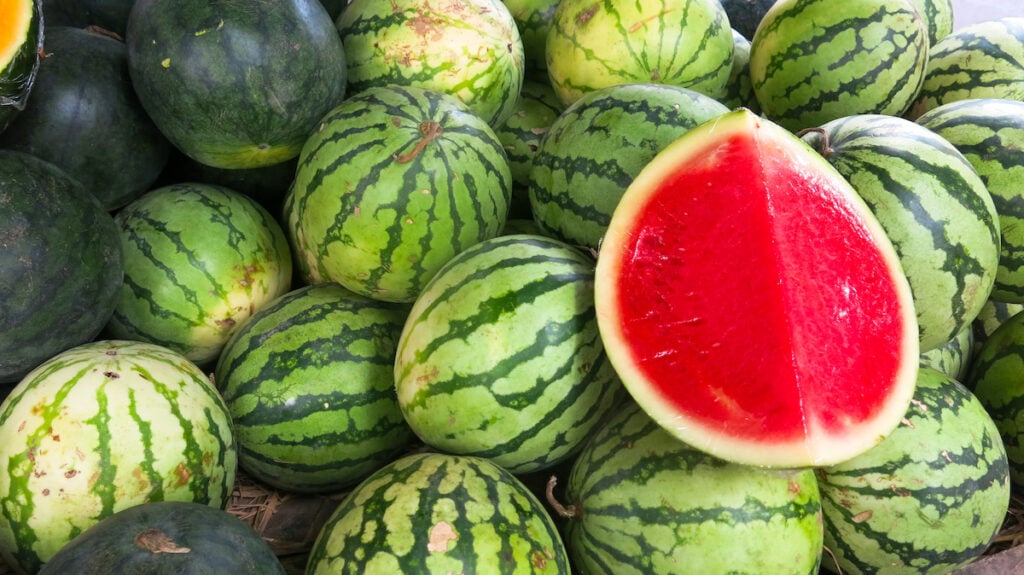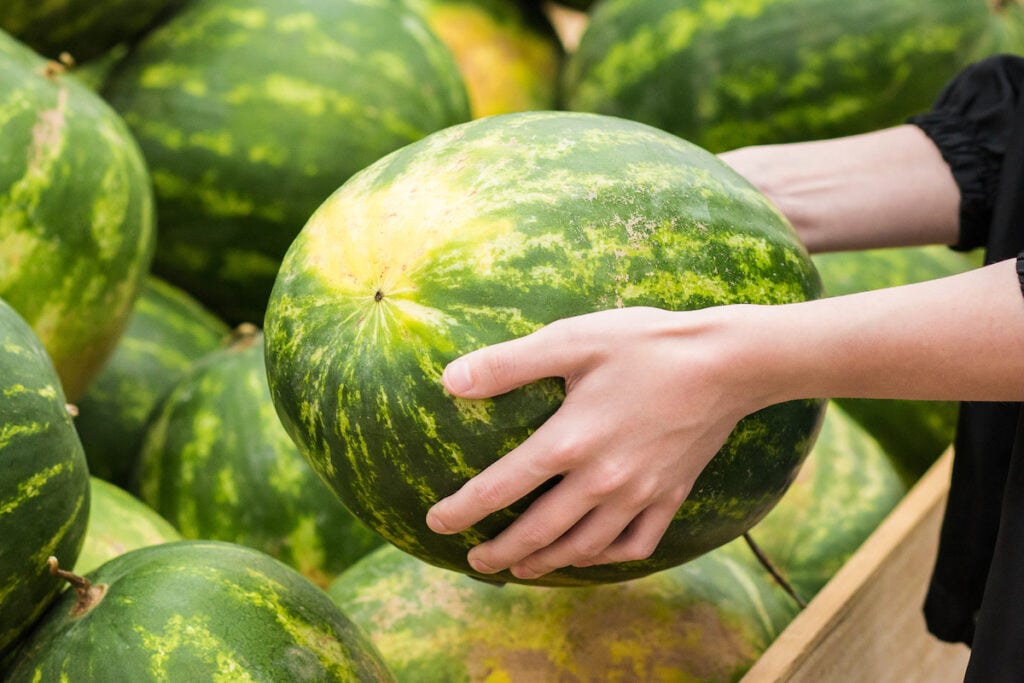How to Pick a Good Watermelon
Nothing says summer quite like eating watermelon. And nothing can bum you right out of your summertime mood than thinking you bought a good watermelon only to discover you did not. Think about it: how many times have you cut into a watermelon and discovered the flesh inside was soft and mealy? Me? Too many times to count.
That’s why I’m thrilled to be bringing you this article on how to pick a good watermelon and perfectly ripe melon. Toss out the old wives tales and bring in some solid advice so that you never again come home from the farm stand, farmers market or grocery store with a bum watermelon.

How to pick a good watermelon
This page may contain affiliate links, which means I may be compensated if you click a link. However, there is no cost to you. Also, as an Amazon Associate, I earn from qualifying purchases. For more info, please see my Privacy and Disclosure page.
When it comes to selecting a watermelon, appearance is a good starting point. These are the five characteristics that will tell you whether or not you’re picking a good watermelon:
- Shape
- Skin texture
- Relative weight
- Stripes on the skin
- Field spot
What shape do you want for a watermelon?
Choose a watermelon that is symmetrical and uniform in shape. Irregularities or asymmetry might indicate an uneven ripening process. A round watermelon that is symmetrically shaped is more likely to have a well-rounded — no pun intended —flavor and texture profile.
Ideally, you want a watermelon with consistent thickness throughout. If you notice any bulges or indentations, it could suggest uneven ripening or the presence of empty cavities. A uniformly shaped watermelon ensures that you get the maximum amount of juicy, sweet flesh with every slice.
A watermelon that is round or oval-shaped tends to have a higher chance of having a well-developed, juicy center. On the other hand, irregularly shaped or elongated watermelons may have less desirable flesh-to-rind ratio, resulting in a less satisfying eating experience.
What should you look for in terms of the skin texture?
Look for a watermelon with a firm, smooth skin. Avoid melons with bruises, cuts, irregular bumps or dents, as they may be overripe or damaged.
Contrary to what you may expect, a ripe watermelon will have a matte or dull skin finish, rather than a shiny or glossy appearance. This is especially true for the darker green parts of the skin. The lack of shine indicates that the watermelon has reached its peak ripeness and is ready for you to enjoy it.
Gently press your fingers against the skin, it should offer a slight resistance but still feel relatively firm. If the skin feels overly soft or mushy, it is an indication of an overripe or potentially spoiled watermelon. On the other hand, a hard or rigid skin suggests an underripe fruit that may lack the desired juiciness.
Why does the watermelon weight matter?
Weight is a crucial factor when it comes to selecting a watermelon. A heavier melon indicates a higher water content, which means it will be juicier and more flavorful.
Keep in mind that you have to think about weight relatively. Obviously a larger melon will weigh more than a significantly smaller melon. You want a higher weight ratio for the size, not simply the heaviest watermelon.
In the store, pick up a few watermelons of similar size and compare their weights. Choose the heaviest one among them as it will likely be the juiciest.
A ripe watermelon should feel dense when you pick it up. If it feels light for its size, it may have dried out or be underripe. Both lead to a disappointing experience.
What do the stripes on a watermelon mean?

The stripes on a watermelon’s skin can provide valuable insight into its ripeness. Here are some things to keep in mind.
- Look for watermelons with dark green stripes that have a high contrast with the lighter green stripes. This contrast indicates that the melon has had enough time to ripen fully.
- Be sure you pick a watermelon with stripes that are evenly sized and well-defined across the melon. Uneven or faded stripes may be a sign of an under ripe watermelon.
- The thickness of the stripes can also reveal insights into the sugar accumulation within the watermelon. As the fruit ripens, it generates more sugar, which enhances its sweetness.
- Thick and well-defined stripes indicate sugar accumulation, suggesting a sweeter and more flavorful watermelon. Thinner or indistinct stripes may suggest lower sugar content, leading to a less sweet or less ripe fruit.
Should your watermelon have a field spot?
The field spot, also known as the belly or ground spot, is the area where the watermelon was resting on the ground. It can offer valuable information about the fruit’s ripeness.
“The first thing I look for when buying a watermelon is a yellow spot on the bottom,” says Jere’ Cassidy of One Hot Oven. “This means the watermelon has been on the vine long enough to be ripe.”
This was the advice my own mother taught me about picking good watermelons. So, like Jere, when shopping for a watermelon, I do look for that field spot. However, there are some caveats to that rule.
One, a ripe watermelon will have a creamy yellow or orange-colored field spot. Avoid melons with a white or greenish field spot, as they are likely underripe.
Two, you want to make sure that the color of the field spot should be consistent across the entire area. An uneven or partially white field spot may indicate an uneven ripening process.
Finally, you want a relatively large field spot. The larger the field spot, the longer the watermelon sat on the ground ripening rather than being picked before it was fully ripe.
Other spots
In addition to field spots, you’ll want to look for something called sugar spots on your watermelon. These are also lighter areas on the skin that show that sugar is basically collecting under the watermelon’s skin. This is a good sign that you’re holding a sweet melon.
A good watermelon has well-balanced flavor, with just the right amount of sweetness accompanied by a subtle hint of natural acidity. You want each juicy bite to have a crisp and firm texture, providing a satisfying crunch that adds to the overall enjoyment.
Whether you plan to make watermelon granita, spicy watermelon salsa or enjoy sliced watermelon on a picnic, you want a sweet, juicy watermelon like you remember from childhood.
Final thoughts
Picking the best watermelon doesn’t have to be a daunting task. Just like when picking a good avocado, by considering the appearance, weight, stripes and field spot, you can increase your chances of selecting a deliciously juicy melon. The next time you’re at the grocery store or farmers’ market, use these tips to find the perfect watermelon and enjoy the best of what this delightful fruit has to offer.
Portions of this article first appeared on Food Drink Life.
